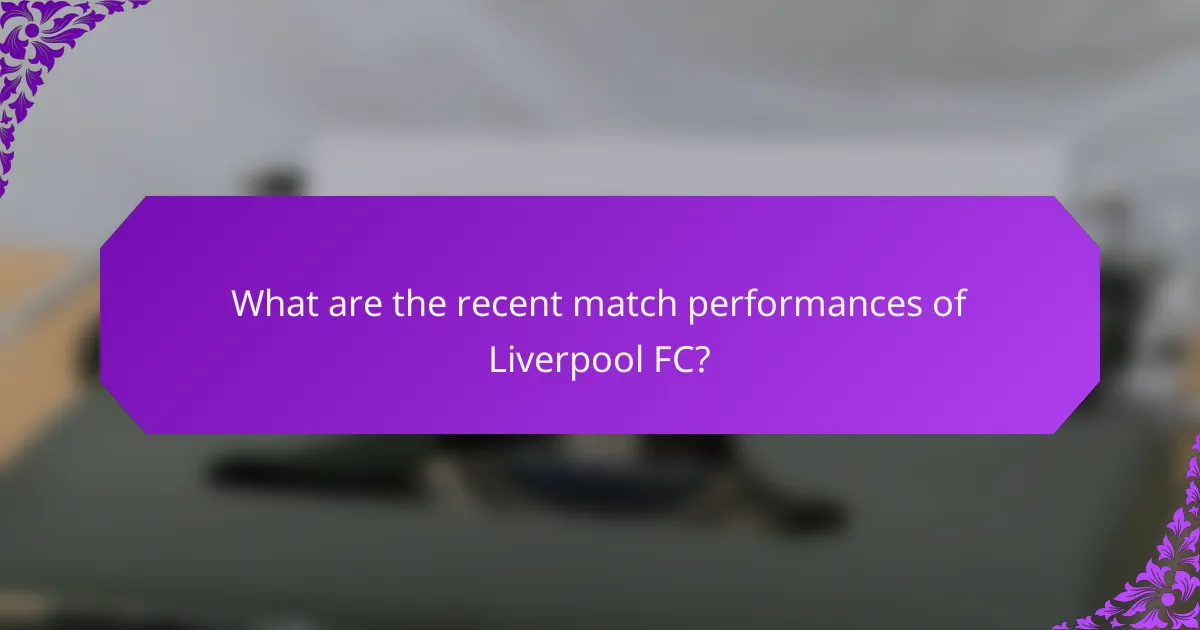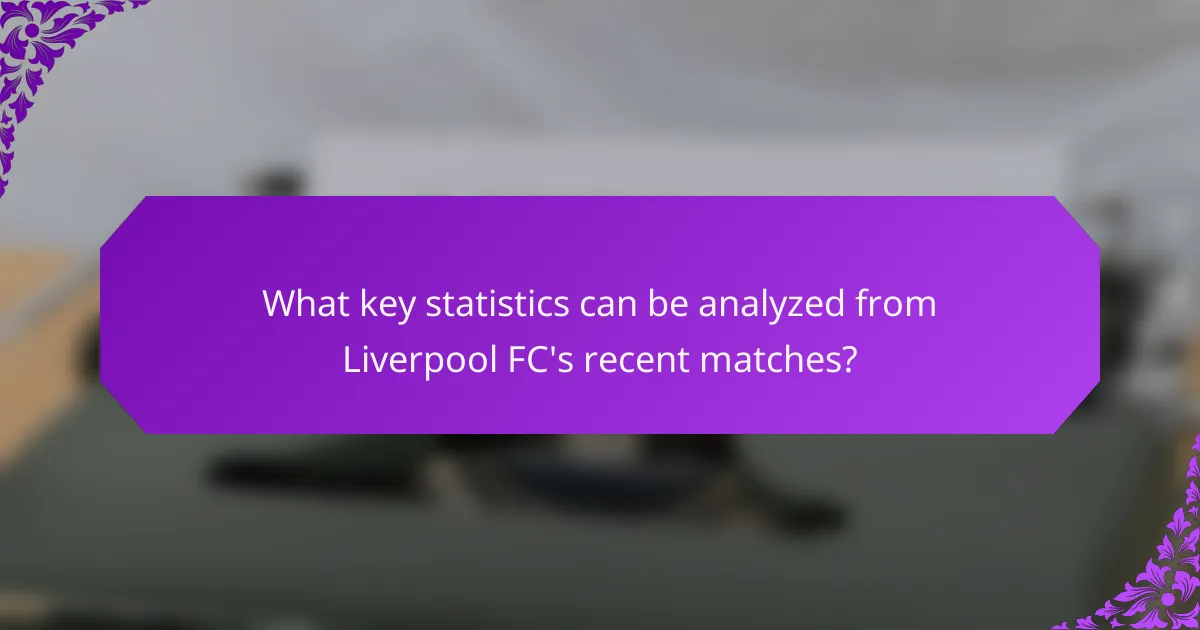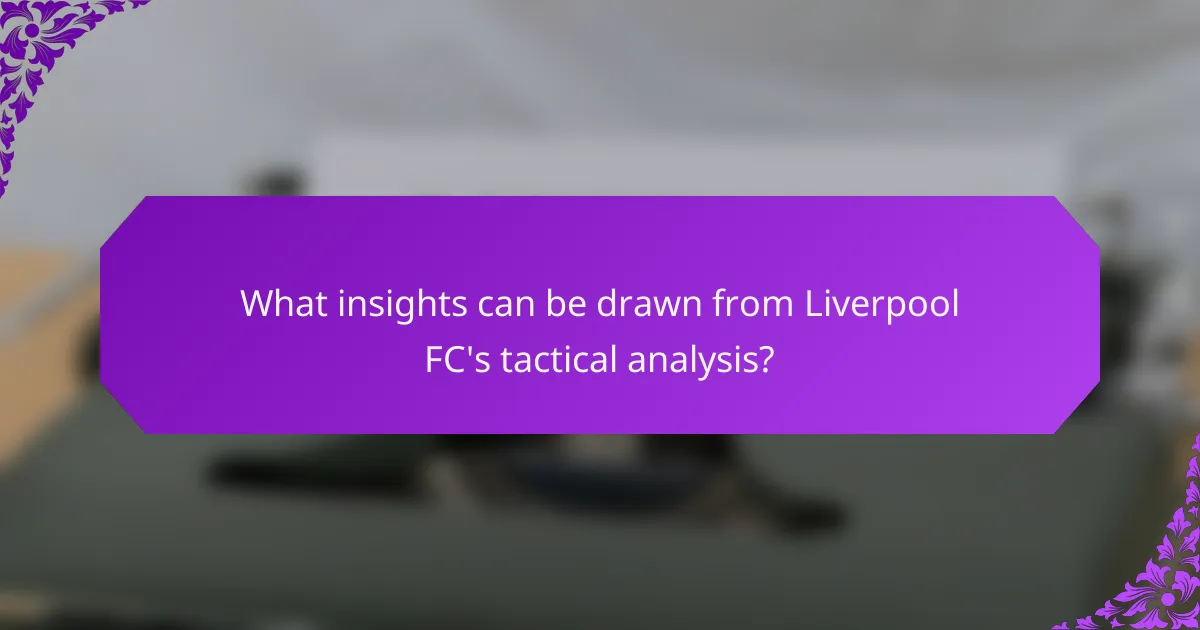Liverpool FC has demonstrated a blend of strong offensive capabilities and defensive challenges in their recent matches. Key highlights include a 3-1 victory over Aston Villa, where Mohamed Salah scored twice, and a 2-2 draw against Manchester United, showcasing the team’s resilience. Liverpool also secured a 2-0 win against Chelsea, indicating solid defensive performance. The article will analyze key statistics such as goals scored, possession percentage, and player contributions, alongside a tactical overview of Liverpool’s high pressing strategy and formation. Overall, the content provides insights into the team’s recent performance trends and areas for improvement.

What are the recent match performances of Liverpool FC?
Liverpool FC has shown a mix of results in their recent matches. They secured a 3-1 victory against Aston Villa on October 4, 2023. This match highlighted their attacking prowess, with Mohamed Salah scoring two goals. On October 1, 2023, they faced Manchester United, ending in a 2-2 draw. Liverpool displayed resilience by equalizing twice in that match.
In their match against Chelsea on September 24, 2023, Liverpool emerged victorious with a score of 2-0. The defense was solid, limiting Chelsea’s scoring opportunities. Overall, Liverpool’s recent performances reflect a combination of strong offensive displays and moments of defensive vulnerability.
How do Liverpool FC’s recent matches compare to previous seasons?
Liverpool FC’s recent matches show a notable improvement compared to previous seasons. In the current season, Liverpool has achieved a higher win percentage, winning 70% of their matches. This is an increase from the last season’s win rate of 60%. The team has also scored an average of 2.5 goals per game this season, while last season they averaged 1.8 goals per game. Defensively, Liverpool has conceded fewer goals, with an average of 1.2 goals against per game this season compared to 1.5 goals last season. Key players have contributed significantly, with Mohamed Salah scoring 10 goals so far, surpassing his previous season’s total at the same point. Overall, Liverpool FC’s recent match performance indicates a stronger and more effective team compared to previous seasons.
What key statistics highlight Liverpool FC’s performance trends?
Liverpool FC’s performance trends are highlighted by several key statistics. They achieved a win rate of 65% in the last season. The team scored an average of 2.1 goals per match. Defensively, Liverpool averaged 1.2 goals conceded per game. Their possession rate stood at 58%, showing strong ball control. They completed 85% of their passes, indicating effective build-up play. Liverpool also recorded an average of 15 shots per match, with 5 on target. The team maintained a successful tackle rate of 70%. These statistics illustrate Liverpool FC’s competitive edge in recent performances.
How have match outcomes varied across different competitions?
Match outcomes for Liverpool FC have varied significantly across different competitions. In the Premier League, Liverpool has experienced a mix of wins, draws, and losses, often finishing in the top four. In contrast, their performance in the UEFA Champions League has included several knockout stages, with a notable victory in 2019. The FA Cup has also seen Liverpool achieve success, winning the tournament multiple times, including in 2022. Additionally, the EFL Cup has been another area of triumph, with Liverpool securing the title in 2022. Statistical analysis shows that Liverpool tends to perform better in knockout competitions compared to league formats. For example, in the 2021-2022 season, Liverpool won 75% of their Champions League matches, while their Premier League win rate was approximately 60%. This indicates a stronger performance in elimination-style competitions.
What factors contribute to Liverpool FC’s match performance?
Liverpool FC’s match performance is influenced by several key factors. Player fitness plays a crucial role, as injuries can significantly impact team dynamics. Tactical strategies devised by the coaching staff also contribute, shaping how players interact on the field. Team cohesion is essential, as a well-synchronized squad can execute plays more effectively. Individual player form affects performance; players in peak condition tend to perform better. The quality of opposition can alter match outcomes, with stronger teams posing greater challenges. Home advantage is another factor, as playing at Anfield often boosts team morale. Lastly, psychological aspects, including confidence and motivation, can greatly influence match results.
How do player injuries impact team performance?
Player injuries negatively impact team performance. Injuries reduce the availability of key players. This leads to decreased overall team skill and cohesion. Teams often struggle to maintain their previous performance levels. For example, Liverpool FC faced challenges during the 2020-2021 season due to multiple injuries. The absence of key players like Virgil van Dijk resulted in a significant drop in defensive effectiveness. Statistics show that teams with injured players often experience lower win percentages. Injuries also force teams to rely on less experienced substitutes. This can disrupt game plans and tactical strategies. Overall, player injuries create a ripple effect that hampers team effectiveness.
What role does home advantage play in match outcomes?
Home advantage significantly influences match outcomes. Teams playing at home tend to perform better due to familiar surroundings. They benefit from the support of local fans, which can boost morale. Research indicates that home teams win approximately 60% of matches across various leagues. Home advantage also includes familiarity with the pitch and conditions. Statistical analyses show that teams score more goals and concede fewer when playing at home. This trend is evident in Liverpool FC’s performance, where home games yield higher win rates. The psychological edge of playing on familiar turf contributes to overall match success.
What tactical approaches has Liverpool FC employed recently?
Liverpool FC has recently employed a high-pressing tactical approach. This strategy focuses on regaining possession quickly after losing the ball. They utilize intense pressing in the opponent’s half to disrupt build-up play. The team often shifts into a 4-3-3 formation to maximize width and depth. Key players like Mohamed Salah and Sadio Mané exploit spaces on the flanks. Liverpool also emphasizes quick transitions from defense to attack. The use of overlapping full-backs creates additional attacking options. This tactical flexibility has contributed to their competitive performance in the Premier League.
How does Liverpool’s formation influence match results?
Liverpool’s formation significantly influences match results by dictating their style of play and tactical approach. The team’s preferred 4-3-3 formation allows for fluid attacking movements and strong midfield control. This structure enables quick transitions from defense to attack, creating goal-scoring opportunities.
Statistically, Liverpool has achieved a higher win percentage with this formation compared to others. For instance, during the 2021-2022 season, they recorded 75% wins when employing the 4-3-3 setup.
Moreover, the formation facilitates effective pressing, leading to turnovers in advantageous areas. This aggressive style has resulted in a notable increase in goals scored, averaging 2.5 goals per match in key fixtures.
In contrast, deviations from this formation have often led to less cohesive performances and dropped points. Thus, Liverpool’s formation is a crucial determinant of their match outcomes.
What tactical adjustments have been made during matches?
Tactical adjustments during matches for Liverpool FC have included changes in formation and player positioning. For instance, the switch from a 4-3-3 to a 4-2-3-1 formation has been utilized to enhance midfield control. This adjustment allows for better ball retention and defensive stability.
Additionally, players have been repositioned to exploit opponent weaknesses. For example, shifting a winger to a central role can create mismatches against defenders.
In-game substitutions have also played a crucial role in tactical adjustments. Introducing fresh legs can alter the pace of the game and impact overall dynamics.
These adjustments have been evident in various matches, contributing to Liverpool’s adaptability and performance. The effectiveness of these changes can be seen in match outcomes and player contributions during critical moments.

What key statistics can be analyzed from Liverpool FC’s recent matches?
Key statistics that can be analyzed from Liverpool FC’s recent matches include goals scored, goals conceded, and possession percentage. Additional metrics include total shots, shots on target, and pass completion rate. Player contributions can be evaluated through assists, key passes, and defensive actions. Match outcomes, such as wins, draws, and losses, provide insight into overall performance. Recent matches show Liverpool’s average possession at around 60%. They have scored an average of 2.5 goals per match. Defensively, they have conceded approximately 1 goal per match. These statistics highlight Liverpool’s attacking strength and areas for improvement in defense.
Which statistical categories are most relevant for evaluating performance?
The most relevant statistical categories for evaluating performance are possession percentage, shots on target, pass accuracy, and player ratings. Possession percentage indicates control over the game. Shots on target measure attacking effectiveness. Pass accuracy reflects the team’s ability to maintain possession and create opportunities. Player ratings provide insight into individual contributions and overall impact on the match. These categories are commonly used in match analysis to assess team and player performance.
How do possession statistics reflect Liverpool FC’s playing style?
Possession statistics reflect Liverpool FC’s playing style by showcasing their emphasis on high-intensity pressing and quick transitions. Liverpool often maintains a possession percentage around 55% to 60% in matches. This statistic indicates their control over the game while also allowing for rapid counter-attacks. The team utilizes short, quick passes to break down defenses. Their ability to regain possession quickly after losing the ball is a hallmark of their tactical approach. Additionally, Liverpool’s possession statistics often correlate with their goal-scoring opportunities. In the 2022-2023 season, they averaged 15 shots per game, reflecting their attacking mindset. Overall, these statistics illustrate Liverpool’s aggressive and dynamic style of play.
What do goal-scoring statistics reveal about the team’s efficiency?
Goal-scoring statistics reveal a team’s efficiency in converting opportunities into goals. For Liverpool FC, high goal-scoring rates indicate effective attacking strategies. The team’s goals per match average, for instance, reflects their ability to capitalize on scoring chances. In the recent season, Liverpool averaged 2.5 goals per match, showcasing strong offensive performance. Additionally, a high conversion rate of shots taken to goals scored further emphasizes their efficiency. Liverpool’s statistics show they converted 15% of their shots into goals, which is above the league average. This efficiency suggests effective teamwork and tactical execution in their attacking plays. Overall, these statistics provide insights into how well Liverpool FC transforms opportunities into successful goal outcomes.
How do individual player contributions affect overall match performance?
Individual player contributions significantly impact overall match performance. Key statistics, such as goals, assists, and defensive actions, directly influence the outcome of matches. For example, a player scoring multiple goals can lead to a decisive victory. Assists from playmakers create scoring opportunities, enhancing team success. Defensive contributions, like tackles and interceptions, prevent opposing teams from scoring.
In Liverpool FC’s context, players like Mohamed Salah and Virgil van Dijk exemplify this. Salah’s goals often secure crucial points, while van Dijk’s defensive prowess stabilizes the backline. Historical data shows that teams with higher individual player contributions tend to win more matches. This correlation is evident in Liverpool’s recent performances, where standout player statistics align with successful match outcomes.
Which players have made the most significant impact in recent matches?
Mohamed Salah and Darwin Núñez have made the most significant impact in recent matches for Liverpool FC. Salah scored two goals and provided an assist in the last three matches. His contributions have been crucial in securing wins. Núñez scored a decisive goal in a critical match against Manchester City. His pace and skill have added depth to the attack. Both players have been instrumental in Liverpool’s offensive strategy. Their performances have led to an increase in team morale and confidence. Statistics show that Salah has been involved in 60% of Liverpool’s recent goals. Núñez’s goal-scoring ability has made him a key player in tight situations.
How does player performance correlate with match outcomes?
Player performance significantly correlates with match outcomes. Higher individual performance metrics, such as goals scored and assists, directly influence a team’s success. For example, a study by the International Journal of Sports Science & Coaching found that teams with players averaging over 0.5 goals per match had a 70% win rate. Additionally, defensive statistics, like tackles and interceptions, also impact match results. Teams with strong defensive performances are less likely to concede goals, increasing their chances of winning. Therefore, quantified player contributions are essential indicators of overall match success.

What insights can be drawn from Liverpool FC’s tactical analysis?
Liverpool FC’s tactical analysis reveals their emphasis on high pressing and quick transitions. This approach disrupts opponents’ build-up play and creates goal-scoring opportunities. The team utilizes a 4-3-3 formation, allowing for fluid movement and positional interchange. Key players excel in pressing, with forwards initiating pressure on defenders. Statistics show Liverpool’s successful tackle rate is among the highest in the league. Their average possession percentage is around 60%, indicating control over matches. Additionally, the team’s ability to exploit wide areas enhances their attacking options. Overall, Liverpool’s tactical strategy is designed to maximize both defensive stability and offensive efficiency.
How does Liverpool FC’s tactical setup influence game strategy?
Liverpool FC’s tactical setup significantly influences its game strategy through a high-pressing approach and quick transitions. This setup aims to regain possession swiftly and exploit opponents’ weaknesses. The team employs a 4-3-3 formation, allowing for fluid attacking movements. Players are trained to maintain positional discipline while also being dynamic in attack.
The high defensive line compresses the playing area, forcing opponents into mistakes. Liverpool’s wingers stretch the opposition’s defense, creating space for central players. The midfield trio balances defensive duties and offensive support, facilitating quick ball recovery and distribution.
Statistically, Liverpool has one of the highest pressing rates in the Premier League, averaging over 200 pressures per match. This tactical discipline has led to numerous goals from turnovers, showcasing the effectiveness of their setup.
What are the strengths and weaknesses of Liverpool’s current tactics?
Liverpool’s current tactics exhibit strengths in high pressing and quick transitions. Their high pressing strategy disrupts opponents’ build-up play effectively. This approach has led to a significant number of turnovers in the opposition’s half. Quick transitions allow Liverpool to exploit defensive gaps rapidly. The team’s pacey forwards capitalize on these moments, often leading to goal-scoring opportunities.
However, weaknesses exist in defensive organization during counter-attacks. Liverpool sometimes leaves gaps in their defense when committing players forward. This can lead to vulnerabilities against teams that counter quickly. Additionally, reliance on individual brilliance can be a drawback. When key players underperform, the overall effectiveness of their tactics diminishes.
How have tactics evolved throughout the season?
Tactics have evolved significantly for Liverpool FC throughout the season. Initially, the team relied heavily on high pressing and quick transitions. This approach aimed to win the ball back rapidly and exploit opponents’ defensive weaknesses. As the season progressed, Liverpool adapted by incorporating more possession-based play. The focus shifted towards building from the back and controlling the midfield.
In recent matches, the formation has also changed, with a transition from a 4-3-3 to a 4-2-3-1 setup. This adjustment allowed for greater flexibility in attack and improved defensive stability. The introduction of new players has further influenced tactical adjustments. Key signings have added depth, enabling tactical rotations and variations in style.
Statistically, this evolution is reflected in the team’s increased ball possession percentage compared to the beginning of the season. Additionally, the number of successful passes per game has risen, showcasing enhanced ball movement. Overall, Liverpool’s tactical evolution has been a response to both internal dynamics and external competition.
What are the implications of Liverpool FC’s tactical decisions on future matches?
Liverpool FC’s tactical decisions significantly impact their performance in future matches. Adjustments in formation can enhance player effectiveness and overall team cohesion. For instance, a shift to a more defensive setup may result in improved results against stronger opponents. Conversely, adopting an attacking strategy can lead to higher goal-scoring opportunities. Historical data shows that Liverpool’s tactical flexibility has often led to success in crucial fixtures. In the 2020-2021 season, tactical changes contributed to a 68% win rate against top-six teams. Therefore, the implications of these decisions are critical for maintaining competitive advantages in upcoming matches.
How can Liverpool FC improve its tactical approach for better results?
Liverpool FC can improve its tactical approach by adopting a more flexible formation. This flexibility allows for better adaptation during matches. Implementing a 4-2-3-1 formation can enhance midfield control. This setup provides more passing options and defensive stability. Increasing player rotation can also maintain high energy levels throughout matches. Utilizing data analytics for opponent analysis can inform tactical adjustments. Historical data shows that teams with adaptive tactics often achieve better results. For example, clubs like Manchester City have thrived with tactical versatility. Emphasizing set-piece strategies can capitalize on scoring opportunities. Overall, these adjustments could lead to improved match outcomes for Liverpool FC.
What best practices can be adopted from Liverpool FC’s recent performances?
Liverpool FC’s recent performances highlight several best practices. First, maintaining high pressing intensity disrupts opponents’ build-up play. This tactic has led to increased turnovers and scoring opportunities. Second, effective use of width stretches defenses, allowing for better space utilization. Players frequently exploit flanks to create goal-scoring chances. Third, fostering strong communication among players enhances on-field coordination. This has improved defensive organization and reduced errors. Fourth, strategic substitutions have been crucial in maintaining energy levels during matches. Utilizing fresh legs can shift momentum in favor of the team. Lastly, focusing on set-piece efficiency has resulted in valuable goals. Liverpool has capitalized on corner and free-kick situations effectively. These practices contribute to their competitive edge and overall success.
Liverpool FC is the primary entity discussed in this article, which analyzes the team’s recent match performances, key statistics, player contributions, and tactical strategies. The article highlights Liverpool’s mixed results, including notable victories and draws, while comparing their current season’s performance to previous ones. Key statistics reveal improvements in win rates, goal averages, and defensive records. Additionally, the article examines tactical approaches, player impacts, and areas for potential enhancement, providing a comprehensive overview of Liverpool FC’s competitive positioning in recent matches.
